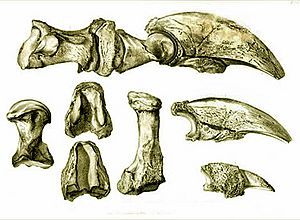Timeline of paleontology in West Virginia facts for kids
For the main article, see Paleontology in West Virginia.
This is a timeline showing important discoveries in paleontology (the study of fossils!) that happened in West Virginia. It also includes work done by people from West Virginia.
Discoveries in the 1700s
The 1790s
1796
- In 1796, a man named John Stuart found some large bones in a cave. Workers were digging for saltpeter (a mineral used to make gunpowder) when they found them.
- The cave was thought to be in Greenbrier County, Virginia at the time.
- Stuart sent the bones to Thomas Jefferson, who later became president.
- Jefferson realized these bones belonged to a new type of animal never seen before! He named it Megalonyx.
- The cave where these fossils were found was later believed to be Organ Cave.
Discoveries in the 1900s
1990
- In 1990, scientists Frederick A. Sundberg and his team found new fossil footprints.
- They named these footprints Hylopus hamesi.
- These tracks were made by ancient amphibians from the late Mississippian age (a time period long ago). They were found in the Bluefield Formation rock layers.
- These footprints were the oldest proof of land animals in the eastern United States.
- The scientists thought the tracks were made by anthracosaurs, which were ancient amphibians. A type of anthracosaur called Proterogyrinus scheelei was also known from West Virginia.
- Some tracks looked like the animal was walking on land, while others suggested it was swimming. This means the animal could move both on land and in water!
1993
- In 1993, two pieces of a Megalonyx shoulder blade were found.
- They were discovered in Haynes Cave in Monroe County, West Virginia.
- This discovery made scientists think that Haynes Cave might be the real place where Thomas Jefferson's Megalonyx bones were found, not Organ Cave.
1995
- In 1995, Fred Grady showed even more proof that the Megalonyx fossils were not from Organ Cave.
- He found that the original discovery site was owned by Frederic Gromer. Gromer never owned Organ Cave, but he did own Haynes Cave.
- Old letters from a later owner of Haynes Cave, Tristram Patton, also described the cave in a way that matched the original discovery. This added more evidence that Haynes Cave was the true site.
Discoveries in the 2000s
2008
- In 2008, Megalonyx jeffersonii was chosen as the official state fossil of West Virginia.

All content from Kiddle encyclopedia articles (including the article images and facts) can be freely used under Attribution-ShareAlike license, unless stated otherwise. Cite this article:
Timeline of paleontology in West Virginia Facts for Kids. Kiddle Encyclopedia.


